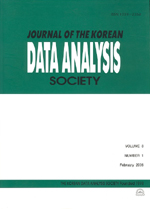선물거래가 주식시장 변동성의 크기 및 비대칭성에 미치는 영향
A Study on the Effects of Futures Trading on the Magnitude and Asymmetry of Stock Market Volatility
- 한국자료분석학회
- Journal of The Korean Data Analysis Society (JKDAS)
- Vol.10 No.3
-
2008.061629 - 1643 (15 pages)
- 67

본 연구는 KOSPI 200 수익률 자료를 이용하여 주가지수선물 거래가 현물 주식시장 변동성의 크기 및 비대칭성에 미치는 영향을 분석하였다. 그리고 수익률의 확률분포가 극첨분포 하는 점을 반영하기 위해, ARMA-EGARCH 모형의 잔차가 일반화오차분포를 한다고 가정하여 모형을 추정하였다. 그리고 분석모형의 적합성을 검정하기 위해 다양한 통계적 검정을 실시하였다.본 연구에서 얻은 주요 분석결과는 다음과 같다. 첫째, KOSPI 200 수익률 시계열은 정규분포를 따르지 않으므로, 그것의 변동성을 추정할 경우에는 일반화오차분포를 가정하는 ARMA- EGARCH 모형이 적합한 것으로 나타났다. 둘째, 주가지수선물 거래 도입 이후 현물주식시장의 변동성 크기가 증가한 것으로 나타났다. 이러한 결과는 선물 거래가 현물시장의 정보 흐름을 촉진시키기 때문이라고 생각된다. 셋째, 현물 주식시장의 변동성에는 비대칭성이 존재하지만, 선물거래 도입 이후 현물시장에서 변동성의 비대칭성이 완화된 것으로 나타났다. 이러한 결과는 주가지수선물 도입 이후 현물시장에서 정보 흐름이 더 빨라지고 시장 참여자들 사이의 정보 비대칭성이 완화되어 현물시장의 효율성이 개선된 것으로 이해될 수 있다.
This paper attempts to analyze the effects of KOSPI 200 index futures trading on the volatility of the underlying spot market in terms of asymmetries. The ARMA-EGARCH model estimated under the assumption of generalized error distribution can capture a lepotkurtic feature of residuals distributions. We also use a variety of diagnostic tests to determine whether estimated models are correctly specified. The main results of our analysis are as follows; First, the ARMA-EGARCH model with the generalized error distribution assumption can capture well the leptokurtosis and asymmetry of the returns series of KOSPI 200. Second, since the introduction of KOSPI 200 index futures trading, the volatility of spot market has been increased, indicating that index futures trading promotes the information flow to the underlying spot stock market. Third, it appears that an asymmetric volatility feature is observed in the KOSPI 200 spot market. In addition, the introduction of index futures trading leads to reduce asymmetric volatility, implying that the role of index futures trading improves the informational transmission, encourages noise or feedback traders to transfer from the spot market to the futures market, and thus makes the spot market more efficient.
1. 서론
2. 이론적 배경 및 선행 연구
3. 분석자료와 분석방법
4. 실증분석 결과
5. 결론
참고문헌
(0)
(0)